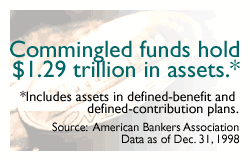NEW YORK (CNNfn) - Mutual funds may be the most common funds into which 401(k) plan money flows. But they may not be the only funds in your plan -- not if the ones you chose were called "commingled pools" or "common funds."
They are similar to mutual funds in some ways: Both are run by professional investment managers in accordance with stated investment goals, and both invest in stocks, bonds and other instruments.
But commingled funds, unlike mutual funds, are not open to individuals -- only to participants in some 401(k) and other qualified retirement plans. And they are not regulated by the Securities and Exchange Commission.
Those differences can affect your return as well as what you know about the fund and when.
Less stringent reporting requirements
Commingled funds, run by banks or trust companies, are overseen primarily by the U.S. Office of the Comptroller of the Currency (OCC) or the state banking authority, depending on whether the institution running the fund is federally or state-chartered. In general, though, most funds follow OCC guidelines, said Bob Colby, vice president and general counsel at Diversified Investment Advisers.
Why should you care? Primarily because the disclosure rules for commingled pools are much less stringent than those for mutual funds. In most instances, the pools only have to price quarterly, and the fund's management does not have to report on the fund's performance or its holdings more than once a year.
Competition leads to more transparency
But the dominance of mutual funds in the 401(k) market and increased pressure to provide daily updates on investments has pushed many commingled pools to offer information more often than is required.
 "Most banks value the (pools) much more frequently," said Jeanie Wyatt, a chartered financial analyst who managed Frost Investment Services' largest commingled equity fund for 15 years. "Most banks value the (pools) much more frequently," said Jeanie Wyatt, a chartered financial analyst who managed Frost Investment Services' largest commingled equity fund for 15 years.
Frost as well as Fidelity's trust company, for instance, price their pools daily, and send investors monthly and quarterly reports.
"That's what investors have come to expect," Wyatt said.
So, too, is media coverage. But if you want to check on your fund, don't bother buying a newspaper. It won't be listed. Commingled pools are not retail funds and do not trade publicly.
To find out about your fund, you have to go to the plan's Web site or call its 800-number, according to Gerry O'Connor, senior research consultant at the Spectrem Group.
"It's an inconvenience for the participants," O'Connor said.
Dollar-for-dollar advantage?
A big benefit, however, is the potential for lower costs. The expense ratio for a commingled fund may be considerably less than a mutual fund with the same investment strategy. And that can mean more money for you since expenses passed on to shareholders are skimmed off your return.
 "It comes down to your net investment return," Wyatt said. "It comes down to your net investment return," Wyatt said.
She cited an example of a Frost small-cap commingled pool and a retail clone of the fund. The same manager runs both funds, but the expense ratio for the commingled pool is 0.3 percent versus 1.1 percent for the retail product. In the 12-month period ended March 31, investors in the Frost fund enjoyed a 36 percent return, while investors in the retail fund only saw a gain of 33.4 percent.
Fewer administrative requirements provide one advantage for the pools, which do not have to satisfy the same costly SEC regulations that mutual funds do, such as appointing a separate board and producing a prospectus, which can involve high legal fees.
Marketing expenses are also less, since the fund is only open to participants in certain 401(k) and pension plans. "Marketing to AT&T and GM is easier than marketing to John Q. Public," said Mike Forrester, a senior vice president of marketing and product management at Fidelity.
Variable annuities may cost you
You may not experience the cost benefits, however, if you invest in a commingled fund under a variable annuity umbrella, O'Connor cautioned. That's because annuities often charge mortality and administrative fees on top of any investment fees, and are more typically found in small plans that have fewer assets.
"Net net, the annuity is going to cost you more," O'Connor said.
No matter how your commingled fund is packaged, however, you should know what expenses you will incur. To find them, check the fund's annual report or any interim reports the fund issues.
So which should you choose?
If you are deciding between a mutual fund and a commingled fund in your 401(k), treat it like any other investment choice, O'Connor said. Compare the funds' performance, cost and the managers' records before committing your money.
Also factor in the transparency cost. But since many commingled funds are moving toward greater disclosure, the gap between mutual and common funds is narrowing in terms of participant advantage.
Today, Wyatt said, "It's a much more level playing field." 
|

